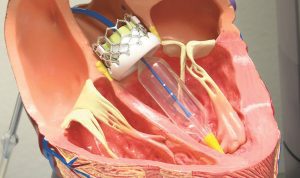By Heidi Smith, Contributor
 According to the American Heart Association, more than 20% of older Americans have aortic stenosis (AS), a condition that can lead to heart failure and death. Today, advances in minimally invasive techniques and technologies allow surgeons and cardiologists to resolve the problem, without a chest incision and frequently with just an overnight hospital stay. Andrew Murray, D.O., FACOI, FACC, FSCAI is an interventional and structural cardiologist who is board-certified in cardiology, interventional cardiology, nuclear cardiology, and internal medicine. He specializes in complex coronary interventions, including a minimally invasive procedure to treat AS. Dr. Murray is a member of the medical staff at ShorePoint Health Venice.
According to the American Heart Association, more than 20% of older Americans have aortic stenosis (AS), a condition that can lead to heart failure and death. Today, advances in minimally invasive techniques and technologies allow surgeons and cardiologists to resolve the problem, without a chest incision and frequently with just an overnight hospital stay. Andrew Murray, D.O., FACOI, FACC, FSCAI is an interventional and structural cardiologist who is board-certified in cardiology, interventional cardiology, nuclear cardiology, and internal medicine. He specializes in complex coronary interventions, including a minimally invasive procedure to treat AS. Dr. Murray is a member of the medical staff at ShorePoint Health Venice.
Q. What is aortic stenosis, and what causes it?
A. Aortic stenosis is narrowing of the aortic valve, which pumps blood from the heart to the body. While some people have a congenital heart defect that causes AS, the condition usually is caused by calcium buildup that increases over time from wear and tear on the valve. The buildup restricts blood flow through the valve, making the heart work harder.
Q. How dangerous is the condition?
A. Mild cases do not require treatment, simply surveillance. However, severe cases that have progressed require timely intervention to prevent heart failure and death.
Q. What are the symptoms of AS?
A. The most common warning symptoms are pain or tightness in the chest, shortness of breath, and syncope or passing out. People with AS may feel fatigued or lightheaded. Usually they cannot do the things they enjoyed only a few months prior. Their physician may also comment that they have a heart murmur or they may have been told that previously.
Q. How do you diagnose AS?
A. In addition to listening to the patient’s description of symptoms and conducting a physical exam, we can use a number of imaging technologies, such as an ultrasound of the heart, to diagnose AS, as well as other heart problems.
Q. What are the treatment options?
A. Medical science has advanced to where we have a number of options for addressing aortic valve stenosis. Our interdisciplinary heart team at ShorePoint Health Venice performs the same procedures – from open heart to minimally invasive – that are done at the largest institutions. A traditional SAVR, or surgical valve replacement, is done by splitting the sternum, or breastbone, and putting the patient on bypass, then cutting out the old valve and sewing in a new one. A TAVR, or transcatheter aortic valve replacement, is performed by making a small hole in the femoral artery in the groin and placing a small tube in to allow us to place a wire into the beating heart. We then balloon open the old valve and use that same wire to insert the new valve over the old.
Q. What are the benefits of TAVR compared to open heart?
A. TAVR is much less invasive. A small hole the size of a large pen is the only external evidence a procedure was performed. There is no need for bypass, and the procedure takes much less time. The patient can usually go home the next day and resume normal activities in about a week.
Q. Can lifestyle choices prevent aortic stenosis?
A. No, unfortunately this disease is a consequence of aging for some people. The best option is careful surveillance and timely treatment. However, with current advances in treatment and therapy, we can offer a meaningful and significant improvement in quality and quantity of life for this serious condition.
ShorePoint Health Venice
(941) 613-5044
ShorePointHealthVenice.com









